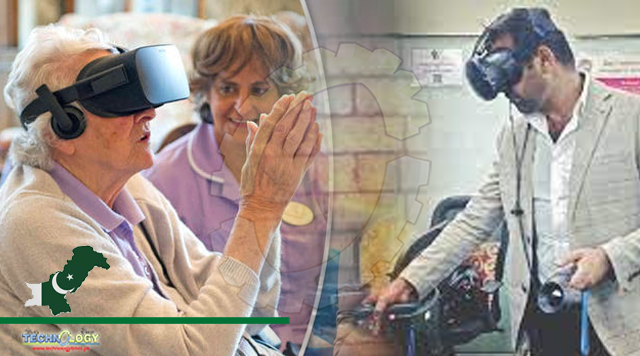Two Pakistani scientists have brought new hope to dementia patients around the world through the use of virtual reality technology

Two Pakistani scientists have brought new hope to dementia patients around the world through the use of virtual reality technology.
The experts recently published the results of a study showing that the decline in brain functions of dementia sufferers could be controlled, or slowed, with the application of VR.
Affecting 55 million people worldwide, dementia, which is less a disease and more a group of related syndromes, is a neurological disorder that manifests itself in a steep decline in brain functions.
The condition destroys memories and personalities, robbing families of their loved ones and sapping patience and finances. With populations ageing, the number of patients worldwide is projected to rise to 78 million by 2030 and 139 million by 2050, the World Health Organization said in a recent report.
There is no known cure for dementia and the focus of therapy has largely remained on slowing its progression.
But now, in a study published in the Brain Sciences journal’s August edition, Pakistani neuroscientist Dr. Ali Jawaid and computer scientist Dr. Suleman Shahid have demonstrated how VR could help those living with dementia cope with their condition.
Jawaid, who is based in Warsaw, Poland, where he leads neuropsychiatric disorders research at the BRAINCITY center at the Nencki Institute of Experimental Biology, told Arab News: “Usually, dementia patients progressively deteriorate in cognitive functions, but what we assessed was that during the whole study, which was more than six months, there was no deterioration.”
His collaborator Shahid directs the Computer Human Interaction and Social Experience Lab at the Lahore University of Management Sciences in Pakistan.
At the core of the two scientists’ latest work has been the employment of VR for environmental enrichment, a term used to describe changing a person’s surroundings to make them more complex, dynamic, and challenging in order to stimulate the brain.
Research on animals has variously found that environmental enrichment could aid the treatment and recovery of brain-related dysfunctions, including Alzheimer’s disease and others related to aging.
“In animals, we have discovered that environmental enrichment is one of the strongest protector factors against cognitive impairment induced by aging. The challenge was how to bring this environmental enrichment to humans,” Jawaid said.
He pointed out that exercise and brain quizzes could work but noted that they were stressful and hardly ever engaging enough for dementia patients to do them regularly or for long periods of time.
What Jawaid and Shahid did instead was to immerse their study’s participants, all with mild dementia, in virtual environments depicting real-world landmarks familiar to them. As all those taking part were Pakistani, the three environments used were the Great Wall of China, the Grand Mosque in Makkah, and the pyramids of Egypt.
In each of the virtual worlds, the patients had to perform tasks designed to stimulate different domains impaired in dementia, such as short-term memory, attention, navigation, motor coordination, or decision making.
For example, in one scenario, a participant would see balloons in the sky as they walked along the Great Wall of China wearing a VR headset. As the sight triggered a childhood memory of shooting balloons, a virtual pistol or a bow and arrow would appear. Once the participant shot the balloons, the next task would be presented.
“We were giving them all this cognitive training in the VR environment, and the results have been extremely encouraging. One of our patients was like, ‘I miss playing golf.’ We arranged that he could play golf in the virtual reality environment. That was really motivating for him,” Jawaid added.
BRAINCITY vice president, Dr. Ewelina Knapska, told Arab News that the way the therapy was designed kept participants engaged much longer than in most other studies of its kind.
“What was done here was the development of a task that was attractive to older people,” she said.
The longer dementia patients were willing to be in therapy that increased brain activity, the more possible it was for them to remain independent, but the cost of such care and therapists is very high. Dementia costs the world $1.3 trillion a year, the WHO report said.
“It (dementia treatment) is very expensive. Such VR therapies are much cheaper and therefore much more accessible,” Knapska added.
Originally published at Arab news